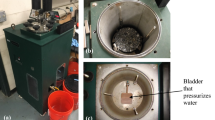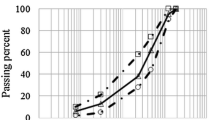Abstract
Asphalt concrete consists of coarse aggregates coated with asphalt binder, matrix, which is a mixture of binder and fine aggregates, and mastic, which is a mixture of asphalt binder and fines passing number 200 sieve (0.075 mm). In this study, nanoindentation tests were conducted on dry and wet mastic materials to determine the contact creep compliance, which is used to examine the effects of moisture in the mastic materials. Indentation creep data were fitted using viscoelastic mechanical models. Results show that the dry mastic materials exhibits viscoelastic behavior, while the wet mastic materials shows less viscoelastic behavior compared to the dry mastic materials. Moisture reduces retardation time significantly in the wet mastic materials. The dry mastic materials follow the linear Burgers viscoelastic model and the wet mastic materials follow the Maxwell viscoelastic model. Stiffness measured on the surface of the wet mastic materials is higher than that of the dry mastic materials. Due to moisture conditioning, mastic sample surface might have eroded that makes it less viscous or become exposed to mastic aggregate, and therefore exhibits high stiffness. Indentation results reveal that the wet mastic is softer below a certain depth from the surface. This study projects that the indenter needs to penetrate more than 4000 nm to reach softer wet mastic materials. Also indentation creep holding time needs be more than 1200 s to reach that target depth in wet mastic materials.












Similar content being viewed by others
References
Spinel SC (2009) A coupled micromechanical model of moisture-induced damage in asphalt mixture: formulation and applications. A&M University, Texas
Ossa EA, Deshpande VS, Cebon D (2005) Spherical indentation behaviour of bitumen. Acta Mater 53:3103–3113. doi:10.1016/j.actamat.2005.01.040
Schilde C, Kwade A (2012) Measurement of the micromechanical properties of nanostructured aggregates via nanoindentation. J Mater Res 27:672–684. doi:10.1557/jmr.2011.440
Allen RG, Little DN, Bhasin A, Lytton RL (2013) Identification of the composite relaxation modulus of asphalt binder using AFM nanoindentation. J Mater Civ Eng ASCE 25:530–539. doi:10.1061/(ASCE)MT.1943-5533.0000615
Oliver WC, Pharr GM (1992) An improved technique for determining hardness and elastic modulus using load and displacement sensing indentation experiments. J Mater Res 7:1562–1583
Tarefder RA, Zaman AM, Uddin W (2010) Determining hardness and elastic modulus of asphalt by nanoindentation. Int J Geomech ASCE 10:106–116
Kim Y, Little DN (2004) Linear viscoelastic analysis of asphalt mastics. J Mater Civ Eng ASCE 16:122–132
Kringos N, Scarpas A, de Bondt A (2008) Determination of moisture susceptibility of mastic-stone bond strength and comparison to thermodynamical properties. J Assoc Asph Paving Technol 77:435–478
Hossain MI, Tarefder RA (2013) Identifying damage in asphalt matrix materials surrounding an aggregate particle. Constr Build Mater 49:536–546. doi:10.1016/j.conbuildmat.2013.08.083
Hodzic A, Kalyanasundaram S, Kim JK et al (2001) Application of nano-indentation, nano-scratch and single fibre tests in investigation of interphases in composite materials. Micron 32:765–775
Schuh CA (2006) Nanoindentation studies of materials. Mater Today 9:32–40
Minster J, Micka M (2012) Numerical simulation of an indentation process for defining the viscoelastic characteristics of time-dependent materials. J Mater Sci Eng 2:81–89
Kurapati SNVRK (2008) Elastic-plastic indentation deformation in homogeneous and layered materials: finite element analysis. University of Kentucky, Lexington
Gupta S, Carrillo F, Balooch M et al (2011) Simulated soft tissue nanoindentation: a finite element study. J Mater Res 20:1979–1994. doi:10.1557/JMR.2005.0247
Wu Z, Baker TA, Ovaert TC, Niebur GL (2012) The effect of holding time on nanoindentation measurements of creep bone. J Biomech 44:1066–1072. doi:10.1016/j.jbiomech.2011.01.039
Gopalakrishnan K, Birgisson B, Taylor P, Attoh-Okine NO (2011) Nano-technology in civil infrastructure: a paradigm shift. Springer, Berlin
Tarefder RA, Faisal H (2013) Effects of dwell time and loading rate on the nanoindentation behavior of asphaltic materials. J Nanomech Micromech ASCE 3:17–23. doi:10.1061/(ASCE)NM.2153-5477.0000054
Tarefder R, Faisal H (2013) Nanoindenthation characterization of asphalt concrete aging. J Nanomech Micromech ASCE 4:1–8. doi:10.1061/(ASCE)NM.2153-5477.0000061
Dai Q, You Z (2007) Prediction of creep stiffness of asphalt mixture with micromechanical finite-element and discrete-element models. J Eng Mech ASCE 133:163–173
Hossain M, Tarefder R (2013) Numerical computation of coupled adhesive and cohesive damages in asphalt concrete. Int J Pavement Res Technol 6:261–268. doi:10.6135/ijprt.org.tw/2013.6(4).261
Caro S, Masad E, Bhasin A, Little D (2010) Micromechanical modeling of the influence of material properties on moisture-induced damage in asphalt mixtures. Constr Build Mater 24:1184–1192. doi:10.1016/j.conbuildmat.2009.12.022
Gubler R, Partl MN, Canestrari F, Grilli A (2005) Influence of water and temperature on mechanical properties of selected asphalt pavements. Mater Struct 38:523–532. doi:10.1617/14317
Nadkarni AA, Kaloush KE, Zeiada WA, Biligiri KP (2009) Using dynamic modulus test to evaluate moisture susceptibility of asphalt mixtures. Transp Res Rec 2127:29–35. doi:10.3141/2127-04
Caro S, Masad E, Bhasin A, Little DN (2008) Moisture susceptability of asphalt mixtures, part 1: mechanisms. Int J Pavement Eng 9:81–98
Kim YR (2009) Modeling of asphalt concrete. ASCE Press, Washington, DC
Kim Y, Allen DH, Little DN (2005) Damage-induced modeling of asphalt mixtures through computational micromechanics and cohesive zone fracture. J Mater Civ Eng ASCE 17:477–484
Tarefder RA, Faisal HM (2013) Modeling nanoindentation creep behavior of asphalt binder. Adv Civ Eng Mater ASTM 2:418–440. doi:10.1520/ACEM20130060
Cheng Y, Cheng C (1999) Can stress-strain relationships be obtained from indentation curves using conical and pyramidal indenters? J Mater Res 14:3493–3496
Feng G, Ngan AHW (2002) Effects of creep and thermal drift on modulus measurement using depth-sensing indentation. J Mater Res 17:660–668. doi:10.1557/JMR.2002.0094
Olesiak SE, Oyen ML, Ferguson VL (2010) Viscous-elastic-plastic behavior of bone using Berkovich nanoindentation. Mech Time-Depend Mater 14:111–124. doi:10.1007/s11043-009-9098-5
Sarihan V (1994) Energy based methodology for damage and life prediction of solder joints under thermal cycling. IEEE Trans Compon Packag Manuf Technol Part B 17:626–631. doi:10.1109/96.338733
Goodall R, Clyne TW (2006) A critical appraisal of the extraction of creep parameters from nanoindentation data obtained at room temperature. Acta Mater 54:5489–5499. doi:10.1016/j.actamat.2006.07.020
Faisal HM, Tarefder RA, Weldegiorgis MT (2014) Characterization of asphalt mastic and aggregate phases for moisture damage. Transportation Research Board 93rd Annual Meeting 0001
Lu H, Wang B, Ma J et al (2003) Measurement of creep compliance of solid polymers by nanoindentation. Mech Time-Depend Mater 7:189–207. doi:10.1023/B:MTDM.0000007217.07156.9b
Huang YH (2004) Pavement analysis and design, 2nd edn. Pearson Prentice Hall, Upper Saddle River
Fischer-Cripps AC (2004) A simple phenomenological approach to nanoindentation creep. Mater Sci Eng A 385:74–82. doi:10.1016/j.msea.2004.04.070
Khattak MJ, Kyatham V (2008) Viscoelastic behavior of hydrated lime-modified asphalt matrix and hot-mix asphalt under moisture damage conditions. Transp Res Rec 2057:64–74
Acknowledgments
The National Science Foundation (NSF) through the prestigious CAREER award (NSF Grant no. 0644047) funded the project. Special thanks to Danielle Glassmeyer, Associate Professor, Bradley University, for detail review on language and grammar of this manuscript.
Author information
Authors and Affiliations
Corresponding author
Rights and permissions
About this article
Cite this article
Hossain, M.I., Faisal, H.M. & Tarefder, R.A. Determining effects of moisture in mastic materials using nanoindentation. Mater Struct 49, 1079–1092 (2016). https://doi.org/10.1617/s11527-015-0559-9
Received:
Accepted:
Published:
Issue Date:
DOI: https://doi.org/10.1617/s11527-015-0559-9




